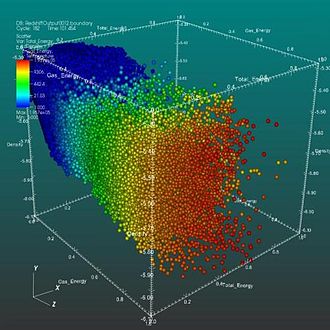Plot (graphics)
Plot (graphics)
A plot in the context of graphics refers to a graphical representation of data. It is a fundamental tool in data visualization and is used to illustrate the relationship between different variables. Plots are widely used in various fields such as statistics, science, engineering, and business to analyze and interpret data.
Types of Plots
There are several types of plots, each serving a specific purpose:
- Line plot: A type of plot which displays information as a series of data points called 'markers' connected by straight line segments. It is commonly used to visualize trends over time.
- Bar chart: A plot that presents categorical data with rectangular bars. The lengths of the bars are proportional to the values they represent.
- Histogram: A type of bar chart that represents the distribution of numerical data. It is used to estimate the probability distribution of a continuous variable.
- Scatter plot: A plot that uses Cartesian coordinates to display values for typically two variables for a set of data. It is used to observe relationships between variables.
- Pie chart: A circular statistical graphic divided into slices to illustrate numerical proportions.
- Box plot: A method for graphically depicting groups of numerical data through their quartiles. It is useful for identifying outliers and understanding the distribution of data.
Components of a Plot
A typical plot consists of several key components:
- Title: Describes the main topic or purpose of the plot.
- Axes: The horizontal (x-axis) and vertical (y-axis) lines that frame the plot. They are labeled to indicate the variables being measured.
- Data points: The individual values plotted on the graph.
- Legend: Explains the symbols, colors, or patterns used in the plot.
- Grid lines: Optional lines that help in reading the values from the plot.
Applications
Plots are used in various applications, including:
- Scientific research: To present experimental data and results.
- Business analytics: To visualize sales trends, market analysis, and financial data.
- Engineering: To analyze system performance and design parameters.
- Education: To teach concepts in mathematics and statistics.
Software for Plotting
Several software tools and programming languages are commonly used for creating plots, including:
- Microsoft Excel
- MATLAB
- R
- Python (with libraries such as Matplotlib, Seaborn, and Plotly)
- GNU Octave
Related Pages
Transform your life with W8MD's budget GLP-1 injections from $125.
W8MD offers a medical weight loss program to lose weight in Philadelphia. Our physician-supervised medical weight loss provides:
- Most insurances accepted or discounted self-pay rates. We will obtain insurance prior authorizations if needed.
- Generic GLP1 weight loss injections from $125 for the starting dose.
- Also offer prescription weight loss medications including Phentermine, Qsymia, Diethylpropion, Contrave etc.
NYC weight loss doctor appointments
Start your NYC weight loss journey today at our NYC medical weight loss and Philadelphia medical weight loss clinics.
- Call 718-946-5500 to lose weight in NYC or for medical weight loss in Philadelphia 215-676-2334.
- Tags:NYC medical weight loss, Philadelphia lose weight Zepbound NYC, Budget GLP1 weight loss injections, Wegovy Philadelphia, Wegovy NYC, Philadelphia medical weight loss, Brookly weight loss and Wegovy NYC
|
WikiMD's Wellness Encyclopedia |
| Let Food Be Thy Medicine Medicine Thy Food - Hippocrates |
Medical Disclaimer: WikiMD is not a substitute for professional medical advice. The information on WikiMD is provided as an information resource only, may be incorrect, outdated or misleading, and is not to be used or relied on for any diagnostic or treatment purposes. Please consult your health care provider before making any healthcare decisions or for guidance about a specific medical condition. WikiMD expressly disclaims responsibility, and shall have no liability, for any damages, loss, injury, or liability whatsoever suffered as a result of your reliance on the information contained in this site. By visiting this site you agree to the foregoing terms and conditions, which may from time to time be changed or supplemented by WikiMD. If you do not agree to the foregoing terms and conditions, you should not enter or use this site. See full disclaimer.
Credits:Most images are courtesy of Wikimedia commons, and templates, categories Wikipedia, licensed under CC BY SA or similar.
Contributors: Prab R. Tumpati, MD







